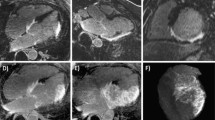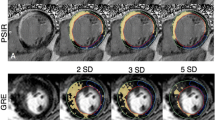Abstract
The aim of this study is to introduce and evaluate an approach for objective and reproducible scar identification from late gadolinium enhanced (LGE) MR by analysis of LGE data with post-contrast T1 mapping from a routinely acquired T1 scout Look–Locker (LL) sequence. In 90 post-infarction patients, a LL sequence was acquired prior to a three-dimensional LGE sequence covering the entire left ventricle. In 60/90 patients (training set), the T1 relaxation rates of remote myocardium and dense myocardial scar were linearly regressed to that of blood. The learned linear relationship was applied to 30/90 patients (validation set) to identify the remote myocardium and dense scar, and to normalize the LGE signal intensity to a range from 0 to 100 %. A 50 % threshold was applied to identify myocardial scar. In the validation set, two observers independently performed manual scar identification, annotated reference regions for the full-width-half-maxima (FWHM) and standard deviation (SD) method, and analyzed the LL sequence for the proposed method. Compared with the manual, FWHM, and SD methods, the proposed method demonstrated the highest inter-class correlation coefficient (0.997) and Dice overlap index (98.7 ± 1.3 %) between the two observers. The proposed method also showed excellent agreement with the gold-standard manual scar identification, with a Dice index of 89.8 ± 7.5 and 90.2 ± 6.6 % for the two observers, respectively. Combined analysis of LL and LGE sequences leads to objective and reproducible myocardial scar identification in post-infarction patients.





Similar content being viewed by others
References
Yan AT, Shayne AJ, Brown KA et al (2006) Characterization of the peri-infarct zone by contrast-enhanced cardiac magnetic resonance imaging is a powerful predictor of post-myocardial infarction mortality. Circulation 114:32–39. doi:10.1161/CIRCULATIONAHA.106.613414
Schmidt A, Azevedo CF, Cheng A et al (2007) Infarct tissue heterogeneity by magnetic resonance imaging identifies enhanced cardiac arrhythmia susceptibility in patients with left ventricular dysfunction. Circulation 115:2006–2014. doi:10.1161/CIRCULATIONAHA.106.653568
Roes SD, Borleffs CJW, van der Geest RJ et al (2009) Infarct tissue heterogeneity assessed with contrast-enhanced MRI predicts spontaneous ventricular arrhythmia in patients with ischemic cardiomyopathy and implantable cardioverter-defibrillator. Circ Cardiovasc Imaging 2:183–190. doi:10.1161/CIRCIMAGING.108.826529
Bello D, Fieno DS, Kim RJ et al (2005) Infarct morphology identifies patients with substrate for sustained ventricular tachycardia. J Am Coll Cardiol 45:1104–1108. doi:10.1016/j.jacc.2004.12.057
Kim RJ, Fieno DS, Parrish TB et al (1999) Relationship of MRI delayed contrast enhancement to irreversible injury, infarct age, and contractile function. Circulation 100:1992–2002
Harrigan CJ, Peters DC, Gibson CM et al (2011) Hypertrophic cardiomyopathy: quantification of late gadolinium enhancement with contrast-enhanced cardiovascular MR imaging. Radiology 258:128–133. doi:10.1148/radiol.10090526
Beek AM, Bondarenko O, Afsharzada F, van Rossum AC (2009) Quantification of late gadolinium enhanced CMR in viability assessment in chronic ischemic heart disease: a comparison to functional outcome. J Cardiovasc Magn Reson 11:6. doi:10.1186/1532-429X-11-6
Amado LC, Gerber BL, Gupta SN et al (2004) Accurate and objective infarct sizing by contrast-enhanced magnetic resonance imaging in a canine myocardial infarction model. J Am Coll Cardiol 44:2383–2389. doi:10.1016/j.jacc.2004.09.020
Tao Q, Milles J, Zeppenfeld K et al (2010) Automated segmentation of myocardial scar in late enhancement MRI using combined intensity and spatial information. Magn Reson Med 64:586–594. doi:10.1002/mrm.22422
Hsu L-Y, Ingkanisorn WP, Kellman P et al (2006) Quantitative myocardial infarction on delayed enhancement MRI. Part II: clinical application of an automated feature analysis and combined thresholding infarct sizing algorithm. J Magn Reson Imaging 23:309–314. doi:10.1002/jmri.20495
Mewton N, Liu CY, Croisille P et al (2011) Assessment of myocardial fibrosis with cardiovascular magnetic resonance. J Am Coll Cardiol 57:891–903. doi:10.1016/j.jacc.2010.11.013
Look DC, Locker DR (1970) Time saving in measurement of NMR and EPR relaxation times. Rev Sci Instrum 41:250–251. doi:10.1063/1.1684482
Messroghli DR, Radjenovic A, Kozerke S et al (2004) Modified look-locker inversion recovery (MOLLI) for high-resolution T1 mapping of the heart. Magn Reson Med 52:141–146. doi:10.1002/mrm.20110
Piechnik SK, Ferreira VM, Dall’Armellina E et al (2010) Shortened modified look-locker inversion recovery (ShMOLLI) for clinical myocardial T1-mapping at 1.5 and 3 T within a 9 heartbeat breathhold. J Cardiovasc Magn Reson 12:69. doi:10.1186/1532-429X-12-69
Nacif MS, Turkbey EB, Gai N et al (2011) Myocardial T1 mapping with MRI: comparison of look-locker and MOLLI sequences. J Magn Reson Imaging 34:1367–1373. doi:10.1002/jmri.22753
Wendland MF, Saeed M, Lauerma K et al (1997) Alterations in T1 of normal and reperfused infarcted myocardium after Gd-BOPTA versus GD-DTPA on inversion recovery EPI. Magn Reson Med 37:448–456
Choi E-Y, Hwang SH, Yoon YW et al (2013) Correction with blood T1 is essential when measuring post-contrast myocardial T1 value in patients with acute myocardial infarction. J Cardiovasc Magn Reson 15:11. doi:10.1186/1532-429X-15-11
Flacke SJ, Fischer SE, Lorenz CH (2001) Measurement of the gadopentetate dimeglumine partition coefficient in human myocardium in vivo: normal distribution and elevation in acute and chronic infarction. Radiology 218:703–710
Xue H, Shah S, Greiser A et al (2012) Motion correction for myocardial T1 mapping using image registration with synthetic image estimation. Magn Reson Med 67:1644–1655. doi:10.1002/mrm.23153
Van de Giessen M, Tao Q, van der Geest RJ, Lelieveldt BPF (2013) Model-based alignment of look-locker mri sequences for calibrated myocardical scar tissue quantification. International Symposium on Biomedical Imaging (ISBI): from nano to macro
Acknowledgments
The authors would like to acknowledge the financial support from the EU MEDIATE Project (ITEA2-09039).
Conflict of interest
None.
Author information
Authors and Affiliations
Corresponding author
Rights and permissions
About this article
Cite this article
Tao, Q., Lamb, H.J., Zeppenfeld, K. et al. Myocardial scar identification based on analysis of Look–Locker and 3D late gadolinium enhanced MRI. Int J Cardiovasc Imaging 30, 925–934 (2014). https://doi.org/10.1007/s10554-014-0402-3
Received:
Accepted:
Published:
Issue Date:
DOI: https://doi.org/10.1007/s10554-014-0402-3




